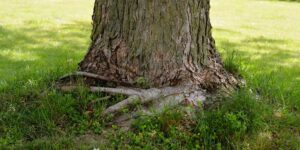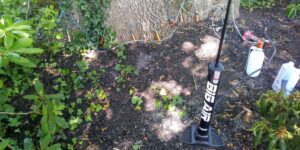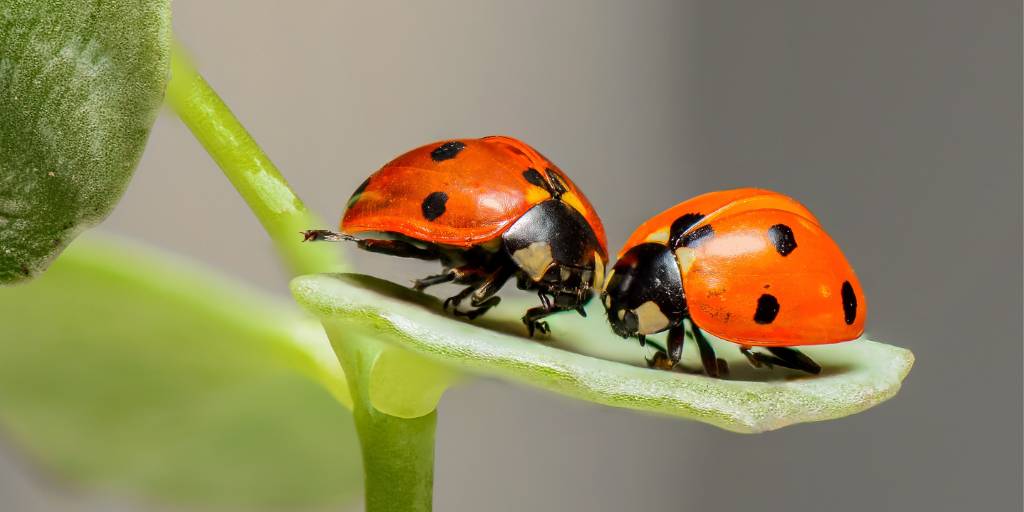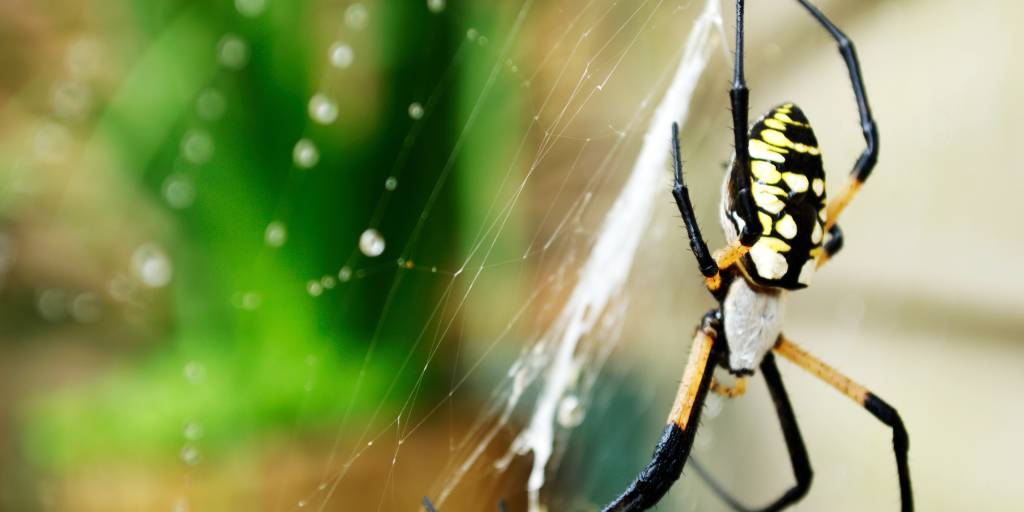If you’ve read our Integrated Pest Management (IPM) article, you’re probably familiar with cultural and biological pest controls. If these terms are new, cultural control generally focuses on physical intervention to reduce or prevent insect and disease problems, whereas biological control employs beneficial garden organisms.
Both methods avoid chemical intervention (pesticides) and are valuable parts of any IPM program. This article will explore and expand on the advantages of beneficial organisms, specifically insects.
What’s the difference between cultural and biological pest control?
Cultural controls rely on non-chemical interventions to lower the number of outdoor pests that affect your trees and landscape plants. There are various methods you can employ:
- Sticky bands around trees to trap pests
- Strategic pruning to dissuade and remove pests
- Scraping visible egg masses from trees and plants
- Hand-picking pests from plants and trees
Each of these cultural control methods puts a premium on physical intervention. Still, some can be labor intensive, and others are inefficient depending on the number and location of pests.
Biological controls use beneficial organisms (such as predatory insects, microscopic nematodes, and specific types of fungi) to control the pest species attacking your trees and garden. Unlike cultural controls, biological controls require little input from you. For example, planting the right mix of trees and plants will naturally attract many beneficial organisms.

Aphids are a common insect pest found on a wide range of plants. While we often think of aphids as being green, they can also be black, orange, brown, white, and other colors.
How do biological controls reduce insect pest populations?
Biological controls keep pest numbers down. How? To put it simply: biological controls kill pests.
All ecosystems, even the small ecosystem you’ve created in your yard, comprise a complex web of interactions among the species and the environment. In a healthy, balanced ecosystem, an increase in pest populations will naturally attract the beneficial insects and other organisms that prey on those pests. This helps to keep the number of pests (and the damage they cause) under control.
What is a beneficial insect?
The definition of a beneficial insect depends on what you’re trying to accomplish in your outdoor space. On the most basic level, a beneficial insect is any insect that positively impacts your trees and garden.
Beneficial insects take advantage of ecology by leveraging predator species against their prey. Of course, this raises a host of new questions like:
- What are the most common beneficial used in biological pest control?
- How do beneficial insects control pests?
- How can I create a habitat beneficial insects will want to live in?
- Can I buy beneficial insects?
- Is purchasing beneficial worth the cost?
Beneficial insects aren’t anything new or exotic. Many common insects you’re already familiar with can benefit your garden and your trees.
What are some common beneficial insects?
Numerous insects fit into the beneficial category. Many of these you’ll have heard of, but some of them may be new to you.
Mantids
You’re probably already familiar with the praying mantis. Getting their name from their folded-arm “praying” posture, they are well-known insect predators.
Mantids occur naturally throughout the majority of the United States. However, mantids require a warmer climate, so their populations only go as far north as Vermont and New Hampshire. Fortunately, they are perfectly suited for New Jersey.
There are two species of mantid native to the United States. These are the Carolina mantis in the Eastern US and the bordered mantis in the Western US. The bordered mantis goes by several common names, including the New Mexico mantis and Arizona mantis.
Two non-native mantis species that have been unintentionally introduced to the United States are the European mantis and the Chinese mantis. While these non-native mantids are also adept insect predators, they are invasive and can disrupt natural ecosystems.
Mantids are voracious predators that will eat a variety of large and small insect pests. They have even been known to eat small reptiles, amphibians, and the occasional hummingbird!
Ladybugs
Bright red or yellow ladybugs (also called ladybirds) on our plants are a pleasant sight. Mild-natured and attractive, these beetles are also capable insect predators.
Common ladybugs consist of several species of the family Coccinellidae. Aside from colorful shells, the characteristic they all share is a voracious appetite for insects, eggs, and more.
A ladybug’s favorite food is aphids, a widespread garden pest. Ladybugs also eat mealy bugs, mites, spiders, and almost any other tiny insect they encounter.
Ladybugs are also beneficial in commercial agriculture, eating the eggs of the European corn borer and the Colorado potato beetle.
But the ladybug’s diet isn’t limited to just other insects. While larval ladybugs are strictly carnivores, some adults feed on pollen from flowers and mildew that grows on plants. And when food is scarce, they are known to eat the larvae and eggs of other ladybugs!

This parasitic braconid wasp is a beneficial garden insect. This wasp parasitizes caterpillars and eats pollen and nectar.
Wasps
You probably didn’t expect wasps to appear on a list of beneficial tree and garden insects, but they’re here for a good reason.
Colony wasps can be a pest with their in-your-face buzzing and potential stings. However, several non-social wasps can help protect your trees and garden.
Many species of tiny parasitoid wasps benefit your plants not by stinging pest insects but by parasitizing them. These wasps use insect pests as part of their life cycle, killing the pests.
These wasp species operate by using their adapted stinger to deposit eggs into caterpillars and other pest larvae. When the eggs hatch, the wasp larvae feed on the insides of their host, killing it. This prevents the pest from reproducing and reduces the damage to your plants and trees.
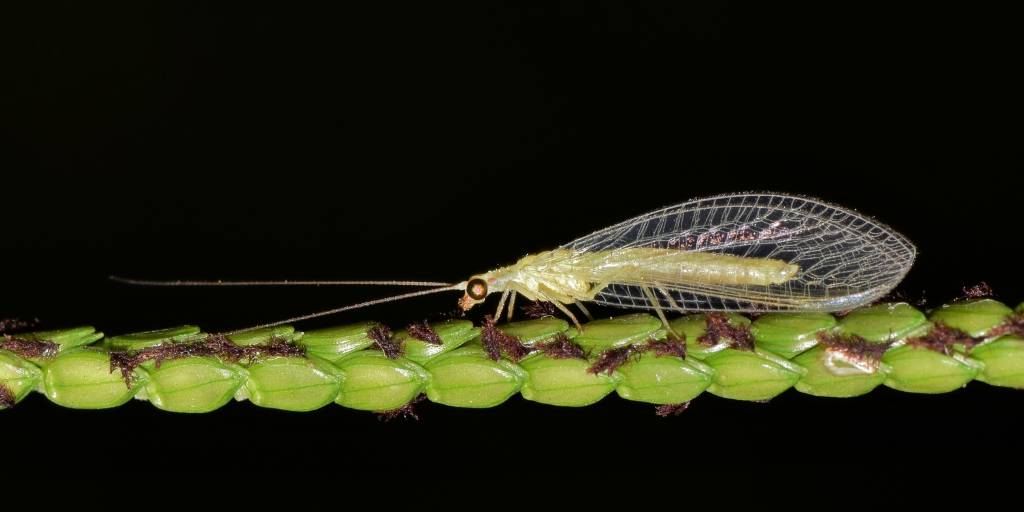
Don’t confuse beneficial lacewings with harmful lacebug! Lacewings lay eggs that look like a tiny green dots on the end of a hair-like structure sticking out of a leaf. If you see those, you know you have lacewings helping to control insect pests in your yard.
Lacewings
Lacewings are a tremendous biological weapon against plant-feeding aphids. Adult lacewings lay their eggs on plants near aphid colonies. When the lacewing larvae hatch, they devour the aphids voraciously.
Two subgroups of lacewings are beneficial in a garden: the green lacewing and the less often spotted brown lacewing.
Both are aphid predators, but green lacewings also eat nectar, pollen, and honeydew (a sweet, sticky substance secreted by aphids). Brown lacewings are strictly predators, preying on aphids, mealybugs, and insect eggs.
Spiders
Spiders are probably the most polarizing beneficial organism on this list. Notice we didn’t call them insects. Though related to insects, spiders are arachnids. Spiders have eight legs to the insects’ six and (usually) make webs to catch their prey.
Spiders work quickly, and you’ve probably woken up to a fully-spun web that wasn’t there the day before. While removing the web is tempting, you should keep it in place as long as it isn’t blocking your path.
Spiders are one of the most common insect predators, eating an estimated 800 million tons of insects annually. And if you still find them a little scary, remember they want nothing to do with you, so there’s nothing to fear in leaving them be when you see them in your outdoor space!
Is buying beneficial insects a good idea?
Beneficial insects are commercially available, but purchasing them isn’t the best option for including them in your garden. What are the downsides?
Commercial Beneficials Often Die Off or Move On
The drawback here is obvious. Introducing a population of beneficial may solve a pest problem temporarily, but these populations often die off after depleting their food source. Others move to new habitats when the food is gone. Either way, this makes your plants available to pests again. Why pay money for something that doesn’t provide continued protection?
Harvested Insects Can Carry Disease
Many beneficial insects, especially ladybugs, are harvested from the wild. The drawback here is wild organisms often carry diseases not found in captive-bred organisms. Introducing these organisms into a non-native region can spread new diseases to native organisms. This exposure can decimate native populations not adapted to fight off novel disease strains.
Non-Native Beneficial Insects Can Outcompete Native Species
Native species have a hard enough time competing against invasives without us adding to the competition. Introducing non-native insect species can upset the balance of an ecosystem in unforeseen ways.
In the case of mantids, our native species are smaller and less aggressive than their invasive counterparts. This compromises our natural ecosystems and creates a real danger to our native species due to increased competition.
Additionally, the larger size and aggressiveness of Chinese and European mantids make them predators of not only pest insects but our native mantids as well!
How can I create a habitat that attracts beneficial insects?
A sustainable alternative to purchasing beneficials is to create a habitat that welcomes them. Here’s how-
Provide Beneficial Insects with Food
Many beneficials are attracted to more than just prey. Some beneficial insects are pollinators, so they’ll be drawn in by flowering plants and trees. In the case of tiny pollinators such as parasitic wasps, small flowers are necessary.
Adding “insectary flowers” to your outdoor space gives tiny predators a source of nectar and pollen. In addition to feeding on the nectar, these predators will eat and parasitize insect pests.
Create Hiding Spaces for Beneficial Insects
If you want beneficials to stick around, they need more than food. When you provide a place for beneficial insects to take refuge, you increase the odds that they’ll remain in your garden.
Adding woodchips, stones, bark dust, and other natural ground covers gives your flightless beneficials a place to hide from predators and a spot to wait and ambush your pests.
Do you need beneficial insect advice from a professional?
Alpine Tree offers a variety of tree health management solutions for your trees, including pest management and fertilization. A professional assessment is a great place to start if you need help setting up your outdoor space to attract beneficials or implement cultural pest controls. Call us at 973-370-0308 to keep your trees and plants healthy!
Need help keeping your New Jersey property and trees pest free? Contact us for an assessment today!


